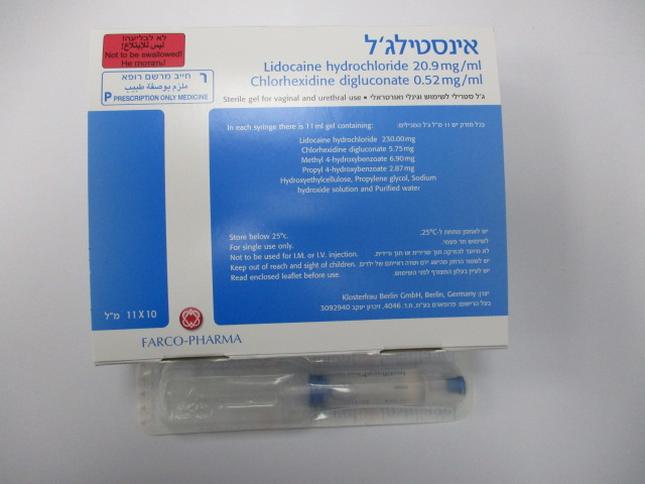Quest for the right Drug

אינסטילג'ל INSTILLAGEL (CHLORHEXIDINE DIGLUCONATE, LIDOCAINE HYDROCHLORIDE)
תרופה במרשם
תרופה בסל
נרקוטיקה
ציטוטוקסיקה
צורת מתן:
לצינור השופכה, וגינלי : URETHRAL, VAGINAL
צורת מינון:
ג'ל : GEL
עלון לרופא
מינוניםPosology התוויות
Indications תופעות לוואי
Adverse reactions התוויות נגד
Contraindications אינטראקציות
Interactions מינון יתר
Overdose הריון/הנקה
Pregnancy & Lactation אוכלוסיות מיוחדות
Special populations תכונות פרמקולוגיות
Pharmacological properties מידע רוקחי
Pharmaceutical particulars אזהרת שימוש
Special Warning עלון לרופא
Physicians Leaflet
Pharmacological properties : תכונות פרמקולוגיות
Pharmacodynamic Properties
5.1. Pharmacodynamic properties Pharmacotherapeutic group: Local anaesthetics – amides ‐ lidocaine, combinations Antiseptics and disinfectants – biguanides and amidines – chlorhexidine, combinations ATC code: N01BB52, D08AC52 For urethral probing, catheterisation and cystoscopy, use of a sterile, sterile‐packed, disinfectant and local anaesthetic gel is required to avoid injuries of the urethra and infections of the lower urinary tract. Instillagel adheres well to the mucosa, has outstanding lubricant properties and leaves the optics of the instruments clear. Instillagel contains the local anaesthetic lidocaine. Lidocaine is a local anaesthetic of the amide type. To avoid secondary infection and hospitalisation, Instillagel contains a disinfectant mix of chlorhexidine digluconate, methyl 4‐hydroxybenzoate and propyl 4‐hydroxybenzoate. Long‐term tests for carcinogenic potential were not conducted with Instillagel or with lidocaine.
Pharmacokinetic Properties
5.2. Pharmacokinetic properties Lidocaine hydrochloride can be absorbed through the mucosa and distributed rapidly in the body. Lidocaine is absorbed only in very low amounts from preparations for urethral use. Unlike local anaesthetics of the ester type, lidocaine is metabolized in the liver and the metabolites are excreted mainly in the urine. Lidocaine is degraded by microsomal oxidative Ndealkylation to monoethylglycinexylidide (MEGX) and acetaldehyde, and 2,6‐xylidine and N‐ethylglycine are produced from MEGX by microsomal hydrolysis; 2,6‐xylidine is metabolized either to 2‐amino‐3‐ methyl‐benzoic acid or, by microsomal oxidation, to 4‐hydroxy‐2,6‐xylidine. The latter is the main metabolite and 73 % of lidocaine is excreted in this form; 4‐hydroxy‐2,6‐xylidine can also be produced directly from lidocaine. The half‐life of lidocaine is about 3 hours; lidocaine crosses the placenta and the half‐life in the foetus is about 4 hours. The substances chlorhexidine digluconate and t h e 4‐hydroxybenzoates contained in very small amounts in Instillagel can also be absorbed through the mucosa to a very small degree and a small amount can reach the blood stream directly through minor lesions. Chlorhexidine, which is hardly absorbed even with oral use in high doses, is eliminated practically unchanged. The 4‐hydroxybenzoates are excreted after hydrolysis in the form of 4‐hydroxybenzoic acid and its derivatives.

שימוש לפי פנקס קופ''ח כללית 1994
לא צוין
תאריך הכללה מקורי בסל
לא צוין
הגבלות
לא צוין
מידע נוסף
